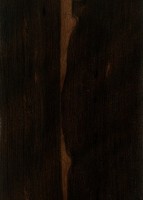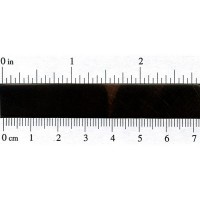 |
Common Name(s): Ceylon Ebony, East Indian Ebony Scientific Name: Diospyros ebenum Distribution: Southeast Asia Tree Size: 50-80 ft (15-25 m) tall, 1-2 ft (.3-.6 m) trunk diameter Average Dried Weight: 57 lbs/ft3 (915 kg/m3) Specific Gravity (Basic, 12% MC): .70, .91 Janka Hardness: 2,430 lbf (10,790 N) Modulus of Rupture: 18,650 lbf/in2 (128.6 MPa) Elastic Modulus: 2,040,000 lbf/in2 (14.07 GPa) Crushing Strength: 9,210 lbf/in2 (63.5 MPa) Shrinkage: Radial: 5.4%, Tangential: 8.8%, Volumetric: 14.3%, T/R Ratio: 1.6 |
Color/Appearance: Heartwood is a jet black, sometimes with grey or dark brown streaks. Pale yellow sapwood is clearly demarcated from heartwood. Ironically, the very best quality ebony looks like black plastic.
Grain/Texture: Grain is typically straight or sometimes irregular, with a fine, uniform texture. Has a high level of natural luster.
Endgrain: Diffuse-porous; medium to large pores in no specific arrangement; solitary and radial multiples of 2-3; heartwood deposits (black) common, which makes it difficult to see individual pores on backdrop of black heartwood; growth rings indistinct; rays not visible without lens; parenchyma diffuse-in-aggregates, vasicentric, banded (reticulate).
Rot Resistance: Portions of black heartwood are very durable regarding decay resistance.
Workability: Overall difficult to work on account of its density and strong blunting effect on cutting edges. Can be difficult to dry, with checks or other drying defects developing. Can be difficult to glue. Ebony turns superbly, and takes a very high natural polish.
Odor: No characteristic odor.
Allergies/Toxicity: Although severe reactions are quite uncommon, Ebony in the Diospyros genus has been reported as a sensitizer. Usually most common reactions simply include eye, skin, and respiratory irritation. See the articles Wood Allergies and Toxicity and Wood Dust Safety for more information.
Pricing/Availability: Although Ceylon Ebony was the original ebony of commerce, it’s seldom available today. Expect prices to be very high, and availability to be very scarce. Other ebonies such as Gaboon or Macassar are more commonly available, though both are also very expensive.
Sustainability: This wood species is not listed in the CITES Appendices, but is reported by the IUCN as being data deficient. Due to exploitation, exporting of this ebony species is restricted in India and Sri Lanka.
Common Uses: Inlay, carving, musical instrument parts (piano keys, bridges, nuts, etc.), and turned objects.
Comments: Still commonly referred to as Ceylon Ebony because the medium-sized tree reached its best development in Sri Lanka (formerly known as Ceylon). It’s also sometimes referred to as East Indian Ebony or simply Indian Ebony.
 |
 |
 |
 |


I have a walking stick made of Ceylon ebony, I am trying to find out how old it is
Are there certified ebony seed sales establishments or not?
If you know of any where to look for them online?
I have white deposits in my Indian ebony. Would you know how to remove them?
East Indian Ebony is known for some mineral deposits. Indian Ebony boards sometimes do contain small mineral deposits but they can be removed using Buriatic acid or staining with luthier dyes or wax oil .
Muriatic acid, Cris, not buriatic.
my great grandpa would make little ebony tubes on his lathe.